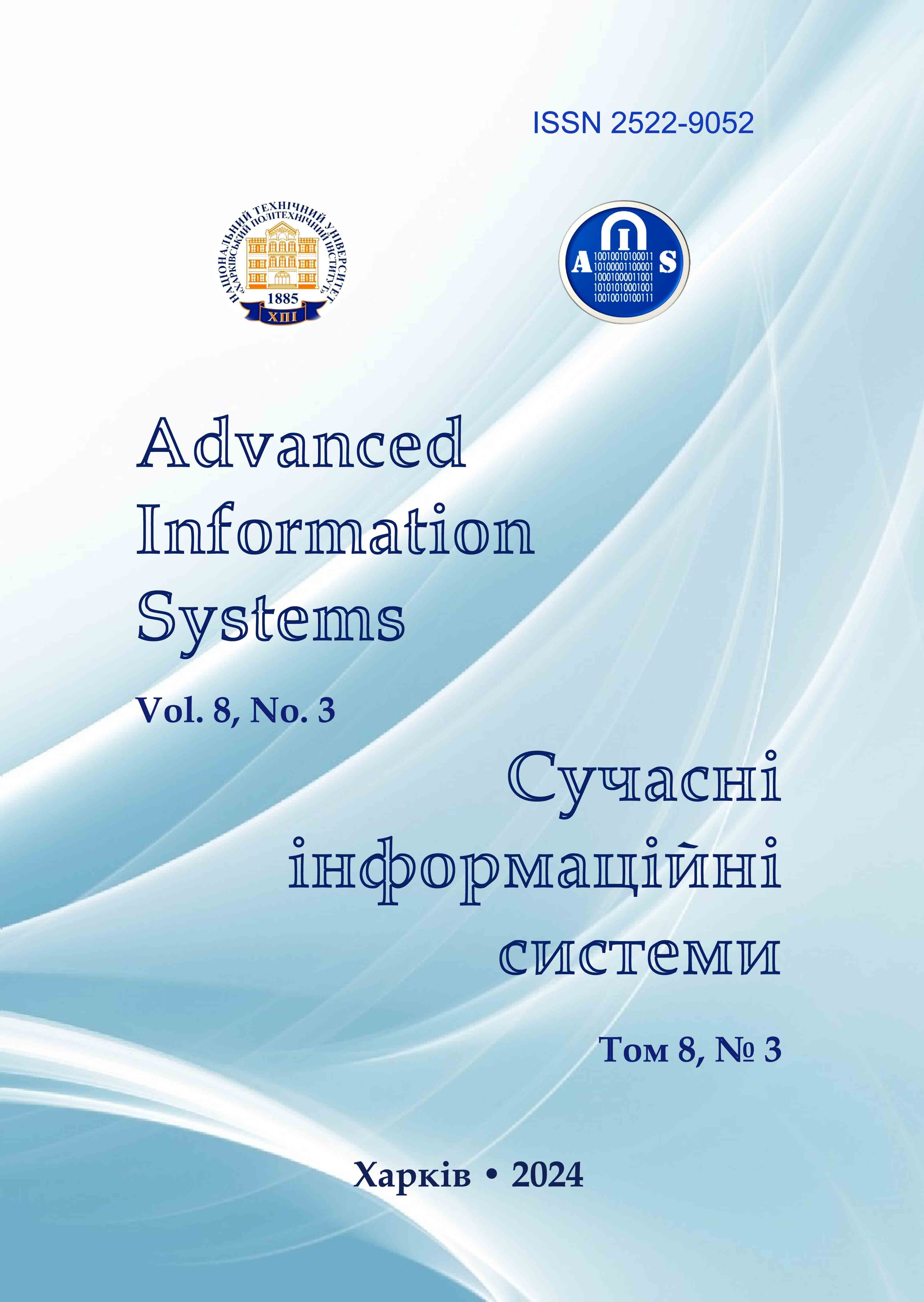THE ISSUE OF TRAINING OF THE NEURAL NETWORK FOR DRONE DETECTION
Main Article Content
Abstract
In the article, the issue of mistaking birds for UAVs, which is considered one of the main problems in the process of detecting unmanned aerial vehicles (UAVs) through cameras, was considered. The object of the study is a method of training an artificial intelligence model so that the detection system does not mistake drones for birds. In order to solve this problem, as an alternative to creating a new complex model, the retraining method was used by making some changes to the previously developed model. The aim of the study is to train an artificial intelligence model using certain methods to detect drones and prevent them from being mistaken for birds. The main result of the research is the training of the artificial intelligence model with the application of the proposed methods for training the model and increasing the accuracy indicators. Also, a dataset was created for both classes, an algorithm was written to retrain the pre-trained model, a fine-tuning process was performed on the model to improve the training and validation performance, and the results were graphically expressed.
Article Details
References
Piriyev, H.K., Hashimov, E.G. and Bayramov, A.A. (2017), Modelling of the battle operations, Monograph, Herbi Nashriat, Baku, 250 p.
Bayramov, A.A. and Hashimov, E.G. (2018), “Assessment of invisible areas and military objects in mountainous terrain”, Defence Science Journal, vol. 68, no. 4, pp. 343–346, doi: https://doi.org/10.14429/dsj.68.11623
Maharramov, R.R. and Hashimov, E.G. (2024), “Detectıon of UAVs wıth electro-optıcal system”, Current dırectıons of development of ınformatıon and communıcatıon technologıes and control tools. Proc. of 14-th Int. Scientific and Technical Conf. ,vol. 2, pp. 74–75, doi: https://doi.org/10.32620/ICT.24.t2
Hashimov, E., Maharramov, R., Sabziev, E. and Pashaev, A. (2023) “Assessment of dead zone of jointly operating radars”, Control, Navigation and Communication Systems. Academic Journal. Poltava: PNTU, 3(73), pp. 171–175, doi: https://doi.org/10.26906/SUNZ.2023.3.171
Hashimov, E., Sabziev, E., Huseynov, B. and Huseynov, M. (2023), “Mathematical aspects of determining the motion parameters of a target by UAV”, Advanced Information Systems, vol.7, no. 1, pp. 18–22, doi: https://doi.org/10.20998/2522-9052.2023.1.03
Seidaliyeva, U., Akhmetov, D., Ilipbayeva, L. and Matson, E. T. (2020), “Real-Time and Accurate Drone Detection in a Video with a Static Background”, Sensors, vol. 20, no. 14, 3856, doi: https://doi.org/10.3390/s20143856
Coluccia, A., Saqib, M., Sharma, N., Blumenstein, M., Magoulianitis, V., Ataloglou, D., Dimou, A., Zarpalas, D., Daras, P. and Craye, C. (2019), “Drone-vs-Bird Detection”, 16th IEEE International Conference on Advanced Video and Signal Based Surveillance (AVSS), Taipei, Taiwan, doi: https://doi.org/10.1109/AVSS.2019.8909876
Thomas, C. (2011), Sensor Fusion – Foundation and Applications, InTech, Rijeka, 240 p., doi: https://doi.org/10.5772/680
Ezuma, M., Erden, F., Anjinappa, C.K., Ozdemir, O. and Guvenc, I. (2019), “Micro-UAV Detection and Classification from RF Fingerprints Using Machine Learning Techniques”, IEEE AERO, USA, doi: https://doi.org/10.1109/AERO.2019.8741970
Wu, M., Xie, W., Shi, X., Shao, P. and Shi, Z. (2018), “Real-Time Drone Detection Using Deep Learning Approach”, 3rd international conference MLICOM, Hangzhou, China, pp. 22–32, doi: https://doi.org/10.1007/978-3-030-00557-3_3
Bayramov A. A., Hashimov, E.G. and Nasibov Y. A. (2021), “Unmanned Aerial Vehicle Applications for Military GIS Task Solutions”, Research Anthology on Reliability and Safety in Aviation Systems, Spacecraft, and Air Transport, IGI Global, pp. 1092–1115, doi: https://doi.org/10.4018/978-1-5225-7709-6.ch010
Taha, B. and Shoufan, A. (2019), “Machine Learning-Based Drone Detection and Classification: State-of-the-Art in Research”, IEEE Access, vol. 7, Toronto, Canada, pp.138669-138682, doi: https://doi.org/10.1109/ACCESS.2019.2942944
Ren, S., He, K., Girshick, R. and Sun, J. (2016), “Faster R-CNN. towards real-time object detection with region proposal networks”, IEEE Transactions on Pattern Analysis and Machine Intelligence, vol. 39, is. 6, China, pp. 1137–1149, doi: https://doi.org/10.1109/TPAMI.2016.2577031
Park, J., Kim, D.H., Shin, Y.S. and Lee, S. (2017), “A Comparison of Convolutional Object Detectors for Real-time Drone Tracking Using a PTZ Camera”, ICCAS, Jeju, South Korea, doi: https://doi.org/10.23919/ICCAS.2017.8204318
Elgendy, M. (2020), Deep learning for vision system, Manning, 480 p., available at:
https://www.oreilly.com/library/view/deep-learning-for/9781617296192/
Saqib, M., Daud Khan, S., Sharma, N. and Blumenstein, M. (2017), “A study on detecting drones using deep convolutional neural networks”, Proceedings of the 2017 14th IEEE International Conference on Advanced Video and Signal Based Surveillance (AVSS), Lecce, Italy, 29 August–1 September 2017, pp. 1–5, doi: https://doi.org/10.1109/AVSS.2017.8078541
Aker, C. and Kalkan, S. (2017), “Using deep networks for drone detection”, Proceedings of the 2017 14th IEEE International Conference on Advanced Video and Signal Based Surveillance (AVSS), Lecce, Italy, 29 August–1 September 2017; pp. 1–6, doi: https://doi.org/10.1109/AVSS.2017.8078539
Nalamati, M., Kapoor, A., Saqib, M., Sharma, N. and Blumenstein, M. (2019), “Drone Detection in Long-Range Surveillance Videos”, Proceedings of the 2019 16th IEEE International Conference on Advanced Video and Signal Based Surveillance (AVSS), Taipei, Taiwan, 18–21 September 2019, pp. 1–6, doi: https://doi.org/10.1109/AVSS.2019.8909830
Davies, E.R. (2012), Computer and machine vision: Theory, Algorithms, Practicalities, Academic Press, USA, doi: https://doi.org/10.1016/C2010-0-66926-4
Antonio, G. and Sujit, P. (2017), Deep Learning with Keras, Birmingham, UK, ISBN:978-1-78712-842-2, 318 p., available at: https://dl.acm.org/doi/10.5555/3153803
(2018), Tensorflow Tutorial, pp. 3–7, available at: https://www.tutorialspoint.com/tensorflow/index.htm
Chollet, F. (2021), Deep Learning with Python, Second Edition, 504 p., ISBN number 9781617296864, available at: https://www.manning.com/books/deep-learning-with-python-second-edition
Chen, Y., Aggarwal, P., Choi, J. and Kuo, C.-C. J. (2017), “A Deep Learning Approach to Drone Monitoring”, 2017 Asia-Pacific Signal and Information Processing Association Annual Summit and Conference (APSIPA ASC), IEEE, Kuala Lumpur, Malaysia, doi: https://doi.org/10.1109/APSIPA.2017.8282120
Kuchuk, H., Kovalenko, A., Ibrahim, B.F. and Ruban, I. (2019), “Adaptive compression method for video information”, International Journal of Advanced Trends in Computer Science and Engineering, vol. 8(1), pp. 66–69, doi: http://dx.doi.org/10.30534/ijatcse/2019/1181.22019
Dotsenko, N., Chumachenko, I., Galkin, A., Kuchuk, H. and Chumachenko, D. (2023), “Modeling the Transformation of Configuration Management Processes in a Multi-Project Environment”, Sustainability (Switzerland), мol. 15(19), 14308, doi: https://doi.org/10.3390/su151914308
Sokolova, M., Japkowicz, N. and Szpakowicz S. (2016), “Beyond Accuracy, F-score and ROC: a Family of Discriminant Measures for Performance Evaluation”, Advances in Artificial Intelligence, vol. 4304, pp. 1015–1021, doi: https://doi.org/10.1007/11941439_114
